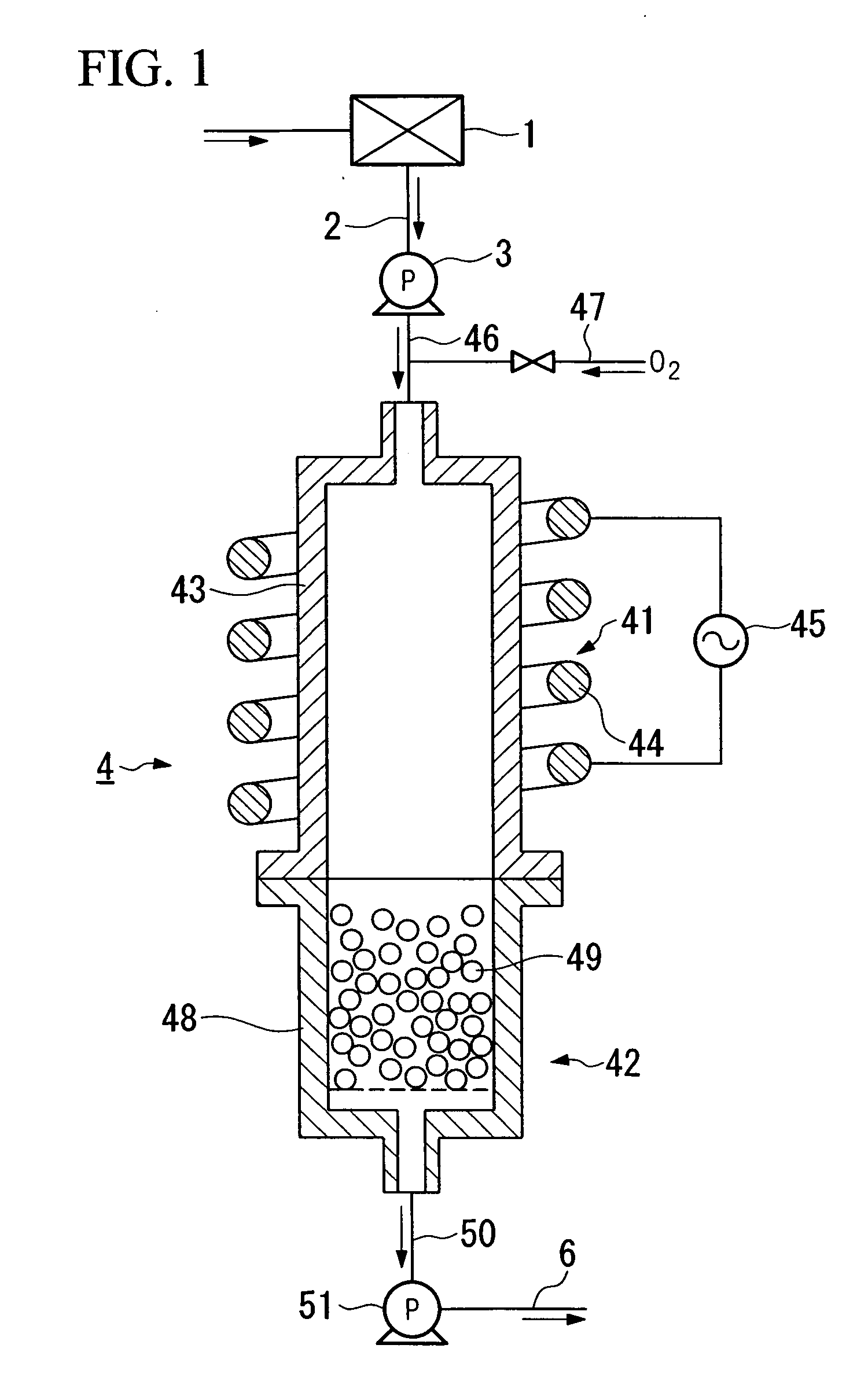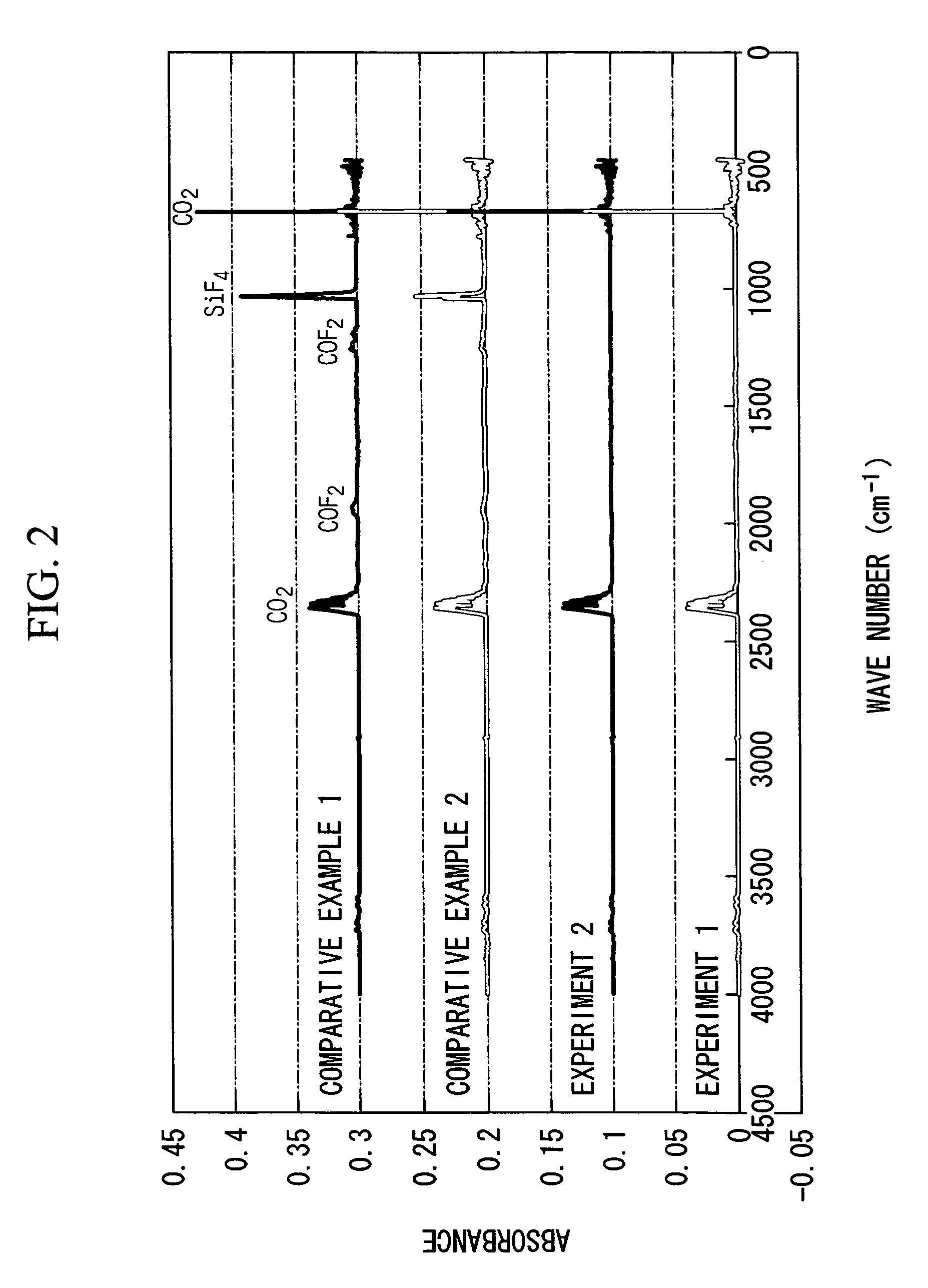Method for treating exhaust gas and apparatus for treating exhaust gas
- Summary
- Abstract
- Description
- Claims
- Application Information
AI Technical Summary
Benefits of technology
Problems solved by technology
Method used
Image
Examples
example 1
[0084] Exhaust gas from semiconductor device production equipment 1 was treated using the treatment apparatus shown in FIG. 1. An alumina cylindrical tube having an inner diameter of 40 mm was used for treatment tube 43 of plasma treatment unit 41, this was wound with a high-frequency coil 44, and a high-frequency current having a frequency of 4 MHz and maximum output of 1.2 kW was applied thereto from alternating current power supply 45 to generate inductively coupled plasma within treatment tube 43.
[0085] In addition, a bottomed cylinder made of quartz having an inner diameter of 40 mm and length of 150 mm was used for reactor 48 of reaction removal unit 42, and the inside thereof was filled with 300 g of particulate calcium oxide having a grain diameter of about 1 mm to a void fraction of 50% by volume.
[0086] Exhaust gas in an excited state was introduced from semiconductor device production equipment 1 into treatment tube 43 through feed line 46 by operating booster pump 3 and...
example 2
[0092] Exhaust gas having a composition of 20% Ar, 78% Xe, 0.1% GeH4, 0.1% B2H6 and 1.8% SiH4 was introduced into treatment tube 43 at a pressure of 50 Torr and flow rate of 200 SCCM using the same treatment apparatus as Example 1. Simultaneous thereto, oxygen at normal pressure was introduced from oxygen supply line 47 into reaction tube 43 at a flow rate of 10 SCCM to generate plasma within treatment tube 43 and degrade the harmful gas components in the exhaust gas by oxidative degradation. Subsequently, the exhaust gas was contacted with calcium oxide to remove the harmful gas components in reaction removal unit 42 in the same manner as Example 1.
[0093] When the amounts of GeH4, B2H6 and SiH4 in the exhaust gas discharged from discharge line 50 were quantified, the amount of GeH4 was less than 3 ppm (detection lower limit), the amount of B2H6 was less than 2 ppm (detection lower limit), and the amount of SiH4 was less than 3 ppm (detection lower limit).
example 3
[0094] Exhaust gas from semiconductor device production equipment 1 was treated using the treatment apparatus shown in FIG. 1. An alumina cylindrical tube having an inner diameter of 40 mm was used for treatment tube 43 of plasma treatment unit 41, this was wound with a high-frequency coil 44, and a high-frequency current having a frequency of 2 MHz and maximum output of 1.5 kW was applied thereto from alternating current power supply 45 to generate inductively coupled plasma within treatment tube 43. In addition, a bottomed cylinder made of stainless steel having an inner diameter of 40 mm and length of 150 mm was used for reactor 48 of reaction removal unit 42, and the inside thereof was filled with 20 kg of particulate calcium oxide having a grain diameter of 3 mm to a void fraction of 50% by volume.
[0095] Exhaust gas in an excited state was introduced from semiconductor device production equipment 1 into treatment tube 43 through feed line 46 by operating booster pump 3 and bac...
PUM
| Property | Measurement | Unit |
|---|---|---|
| Pressure | aaaaa | aaaaa |
Abstract
Description
Claims
Application Information
 Login to View More
Login to View More - R&D
- Intellectual Property
- Life Sciences
- Materials
- Tech Scout
- Unparalleled Data Quality
- Higher Quality Content
- 60% Fewer Hallucinations
Browse by: Latest US Patents, China's latest patents, Technical Efficacy Thesaurus, Application Domain, Technology Topic, Popular Technical Reports.
© 2025 PatSnap. All rights reserved.Legal|Privacy policy|Modern Slavery Act Transparency Statement|Sitemap|About US| Contact US: help@patsnap.com



